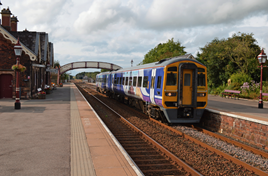Dent station is over four miles from (and 600ft higher than) the village it serves, while the close proximity of the Yorkshire Three Peaks is a graphic reminder of the original purpose of this line.
“People think that this is a line from Settle to Carlisle,” says Rand. “But it wasn’t done for that purpose, but to create a new route to Scotland as straight and level as possible. It was never intended to serve local communities.
“But it is this legacy that has caused Eden Brows, where they could have taken an easier route nearer to the riverbank, but they chanced their arm to build there at all. I imagine there was an arrogant element of ‘we are the Midland Railway and we can do what we want’.
“But we’re very much looking on the positive side of things. When we have through traffic back in March we will have a much better and resilient railway, which is incredible when you think that we were down to two inconveniently timed trains a day in the 1980s. It would have been curtains had Eden Brows happened in 1989, when it would have eclipsed the cost of rebuilding Ribblehead.
“And so it is very much short-term pain for long-term gain. It’s an act of God, but the collateral work being done is deeply appreciated and has sensibly been brought forward. Network Rail is using the blockade to complete other ancillary work and pre-scheduled projects, such as the installation of new barriers, wigwags and fencing at Culgaith Crossing and Low House Crossing.”
As we approach our destination at Armathwaite, the rugged sheep farming landscape of the fells has already given way to the dairy pastures of the lush green Eden Valley away to our right. The Up line has noticeably rusted in the six months since it has been worked, with all traffic turning around at Armathwaite and running wrong line back to the only available crossovers away to the south.
The handful of passengers disembarking here quickly transfer to the waiting road transport for the half-hour trip into Carlisle, before the diesel multiple unit is diagrammed to return to Appleby for an hour’s crew break.
RAIL is met by Network Rail’s scheme project manager Philip Middleton for the short two-mile drive to the worksite - accompanied by Rand, who will be taking pictures for the FoSCL quarterly magazine.
Located almost exactly at milepost 300, a thin strip of land in a field adjacent to the western boundary of the line has been commandeered by NR and Story Contracting. Here they have built the compound that will be expected to handle approximately 110 men and women from different trades across the duration of the project.
Fully kitted out and safety briefed, RAIL is whisked down to the remote main worksite on a ‘gator’ all-terrain vehicle, along some of the 1,400 metres of temporary roads specially built for this purpose.
NR and Story Contracting have worked closely with Natural England to obtain permission to work in what is normally protected woodland, and these roadways will need to be handed back to nature at the end of the project. Four badger setts were also located in the woods - they have been left undisturbed, with exclusion zones thrown around them for their protection.
On the way down to the landslip area we pass a road-rail vehicle (RRV) tipping earth into a wagon hauled by a Class 66. This is one of two weekly trains that NR has been running on the short northern stub of the severed route, to remove excavated spoil from the trackbed at Eden Brows to Carlisle Kingmoor Yard. It is by far the most efficient way to do this - one train carries the equivalent volume of 60 wagons being sent by road.
At the centre of activity, a 145m stretch of track has been lifted, and 9,000 tonnes of spoil have been removed to excavate the track bed to a depth of four metres below the railhead. Sharply falling away to the side, the steep wooded hillside is now partly bare where 2250m2 of vegetation has been cleared to enable ground monitoring.
Ever mindful of environmental considerations, and again working closely with Natural England, NR and Story Contracting moved quickly to get this job done in February and March before the start of the bird-nesting season.
Adam Monkhouse, the site manager for Story Contracting, joins us. “The project can be split into two really - corridor works to get the railway re-opened, and slope works to ensure there’s no more slippage,” he explains.
“We could probably have just shoved something quickly in the ground to keep the line open, but then found it had moved again in five years’ time. We did a lot of ground investigation to inform the right solution, so we don’t have to come back here and do it all again.”
Monkhouse points to scientific measuring equipment perched on a bank of earth above us, that uses lasers to continuously scan the hillside. He says that 10mm of slippage had been detected during the two days before our visit following a period of heavy rainfall, but seems unconcerned by the prospect of further movement.
“The bank re-profiling we’re going to do is designed to stabilise the bank, but even if it does move again the railway will not. The asset structure is designed to isolate itself, so this cannot happen again.”
An excavator is removing the last mounds of earth to enable piling to commence in November, although a small number of temporary piles have already been drilled in place to provide a stable foundation for the imminent arrival of the full-scale piling rigs.
















Login to comment
Comments
No comments have been made yet.